

What Is the Direct-to-Consumer Sales Model and Why Should You Care? After a short stay in bankruptcy last year to reorganize her business, Mellon’s plan now is to sell her shoes directly to consumers online, and perhaps in her own retail stores in the future; bypassing department stores and boutiques entirely.
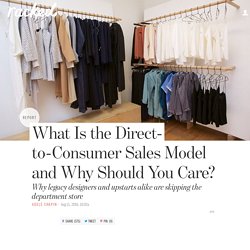
In the meantime, the header on Tamara Mellon’s Facebook page reads: "Excuse me while I rewrite the rules of luxury. " Photo: Tamara Mellon Tamara Mellon isn’t the only designer brand moving to the direct-to-consumer model. Misha Nonoo has discussed similar plans. BBC iPlayer - Absolutely Fashion: Inside British Vogue - Episode 2. Fashion brands struggling to find the right social influencers. Social media influencers are fast becoming brands’ go-to option for generating trust and credibility among young consumers.
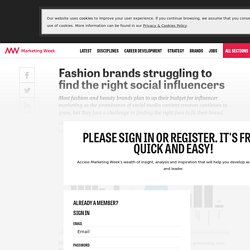
According to a new report by Fashion and Beauty Monitor in association with Econsultancy – both sister brands of Marketing Week – 57% of marketers and business owners in the fashion and beauty sectors use influencers as part of their marketing strategy, with an additional 21% looking to introduce this type of activity over the next 12 months. The growing authority of online commentators and YouTube stars such as Zoella has given rise to this new breed of peer-to-peer brand ambassador. The fact that 41% of respondents have been collaborating with online content creators for three years or more, in what is considered a maturing space, also suggests fashion and beauty firms are ahead of the curve in their use of influencer marketing. Gucci slammed for ‘irresponsible’ ad featuring ‘unhealthily thin’ model.
The ad, which appeared on The Times’ website in December last year, included several photos of models posing.

The ad was investigated after one complainant argued the models were unhealthily thin, making the ad irresponsible. Gucci said the ads were part of a video that portrayed a dance party and was aimed at an older, sophisticated audience. The Times and the luxury fashion retailer said it was, to some extent, a subjective issue as to whether a model looked unhealthily thin. The brand believed both models had slim builds, but were not depicted in a way that could be interpreted as unhealthily thin. It said nowhere in the ads were any models’ “bones” visible, their makeup was natural rather than heavy (which might have accentuated the impression of thinness), lighting was uniform and warm to ensure there were no hollows caused by shadows and their clothes were not revealing. The ASA was not as positive, however, about another model leaning against a wall.
Burberry admits its customer loyalty is ‘lagging’ and marketing needs ‘rebalancing’ Pre-tax profits fell 10% to £415.6m for the year to 31 March, while revenues dropped 1% on an underlying basis to £2.5bn.
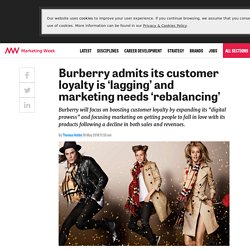
The iconic luxury brand primarily blamed the decline on Asia, citing falling consumption levels, a slowdown in Chinese tourists visiting European stores and weaker demand in Hong Kong. And Burberry expects growth in the luxury sector to continue to slow, with its CEO Christopher Bailey stating that the luxury sector will grow sales by around 2% this year, down from the 7% growth it has experienced over the last five years. Coach, Michael Kors Discounts To Disappear As Luxury Brands Strive To Become More Exclusive Again. Coach and Michael Kors luxury brands are both doing a bit of revamping in an attempt to increase the exclusivity of their brands.
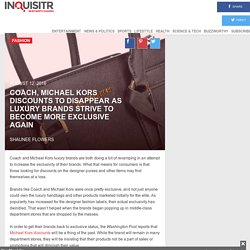
What that means for consumers is that those looking for discounts on the designer purses and other items may find themselves at a loss. Luxury Brands Focus On “Instagram Generation” Ultra Rich Customers. It’s a brave new world out there, though not the one Aldus Huxley envisioned.
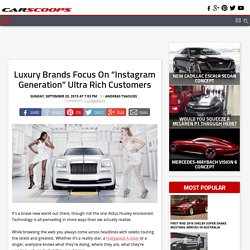
Technology is all-pervading in more ways than we actually realize. While browsing the web you always come across headlines with celebs touting the latest and greatest. Whether it’s a reality star, a Hollywood A-lister or a singer, everyone knows what they’re doing, where they are, what they’re wearing – oh, and what they are driving. The paparazzi will soon be a thing of the past. Celebrities use social media themselves to promote…, well, themselves. To automotive company executives, it sounds like a golden opportunity. Give them what they want, that’s the answer. Everyone is getting on the game.
Luxury footwear brand Jimmy Choo boosted by weaker pound. Celebrity-favourite footwear brand Jimmy Choo has posted rising profits and said it expects a weaker pound in the wake of Brexit to further boost revenues and profits.
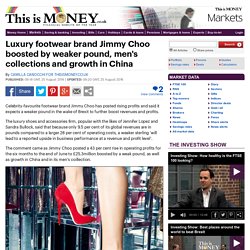
The luxury shoes and accessories firm, popular with the likes of Jennifer Lopez and Sandra Bullock, said that because only 9.5 per cent of its global revenues are in pounds compared to a larger 28 per cent of operating costs, a weaker sterling ‘will lead to a reported upside in business performance at a revenue and profit level’. The comment came as Jimmy Choo posted a 43 per cent rise in operating profits for the six months to the end of June to £25.3million boosted by a weak pound, as well as growth in China and in its men's coillection. Luxury appetite: Jimmy Choo said it saw ‘impressive’ growth in China, which has been a tough market for its competitors recently.
Gucci Among World’s Hottest Fashion Brands, While Prada Cools. LONDON, United Kingdom — Gucci has been named one of the “hottest” luxury brands, while Prada and Giorgio Armani are “cooling” fast, according to a new report by Exane BNP Paribas.

The financial services firm assessed the “brand temperature” of luxury companies, based on the ratio between the editorial coverage they receive in print magazines, and their print advertising spend. Brands are ranked as “hot” if magazines give them more editorial space than their advertising spend should warrant, meaning they have more editorial coverage than print magazine advertisements — reflecting a “hot” level of appeal and desirability — whereas brands that fall below this ratio are “cold.” Gucci’s editorial value was up more than 15 percent for the first six months of the year, compared to the same period last year.
Louis Vuitton and Chanel both also ranked as “hot,” but their editorial value grew at a lower rate of between 0 and 15 percent, despite a high print advertising spend. Source: BoF.